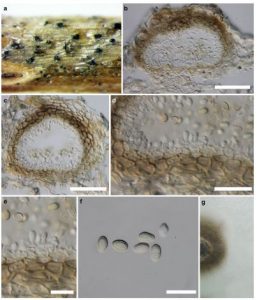Neomicrosphaeropsis rossica Thambugala, Bulgakov & K.D. Hyde, sp. nov. Index Fungorum number: IF552092
Etymology: Named after the country (Russia), where the holotype was collected.
Holotype: MFLU 14–0605
Saprobic or weak pathogen on twigs of Tamarix ramosissima Ledeb. Sexual morph: Undetermined. Asexual morph: Conidiomata 85–150 μm high × 90–150 μm diam. (x = 122 × 121 μm, n = 10), pycnidial, gregarious, scattered or solitary, immersed slightly erumpent, black, globose to subglobose, uniloculate, ostiolate. Conidiomatal wall 15–30 μm wide, consisting of 3–5 layers of brown cells of textura angularis, becoming hyaline towards the conidiogenous region. Conidiogenous cells (2–)3–4.6 × 2– 4 μm (x = 3.8 × 3 μm, n = 15), enteroblastic, phialidic, hyaline, cylindrical, discrete or integrated, smooth. Conidia 4.4–5.7(−6.3) × 2.9–3.9 μm (x = 5.3 × 3.4 μm, n = 35), hyaline when immature, becoming light brown, aseptate, ellipsoidal, obovoid or globose, smooth-walled.
Culture characteristics: Conidia germinating on PDA within 18 h. Colonies growing on PDA reaching 30 mm diam. After 10 days at 25 °C, circular, flat, moderately dense, surface dark olivaceous brown, smooth surface with entire to slightly undulate edge.
Material examined: RUSSIA, Rostov Region, Oktyabrsky District, Persianovsky Township, arboretum of Don State Agrarian University, Tamarix ramosissima Ledeb. (Tamaricaceae), 4 June 2014, Timur Bulgakov 79 (MFLU 14–0605, holotype), ex-type living culture MFLUCC 14– 0586, ICMP 20753.
Notes: Neomicrosphaeropsis rossica is introduced as a new species and this species mainly differs from N. italica, the type species of the genus, in having uniloculate conidiomata which are smaller and recorded from a different host species in a different country (Russia). In the present phylogenetic analysis of combined LSU, ITS, RPB2 and β- tubulin sequence data, N. rossica formed a separate subclade in the Neomicrosphaeropsis clade in Didymellaceae with high BS support (96 %). Neomicrosphaeropsis rossica shares similar morphology with Coniothyrium tamaricis, but the conidial dimensions are slightly different and the taxa are recorded from different hosts (Tamarix gallica L.) and continents (Saccardo 1902). Therefore, C. tamaricis can be another species that may represent Neomicrosphaeropsis and needs to be recollected from the same location and analyzed with gene sequence data to confirm its placement.
FIG Neomicrosphaeropsis rossica (MFLU 14–0605, holotype) a Appearance of conidiomata on host surface b, c Vertical sections through conidiomata d, e Conidiogenous cells and developing conidia f Conidia g Culture growing on PDA. Scale bars: b, c = 50 μm, d = 20 μm, e, f = 10 μm

